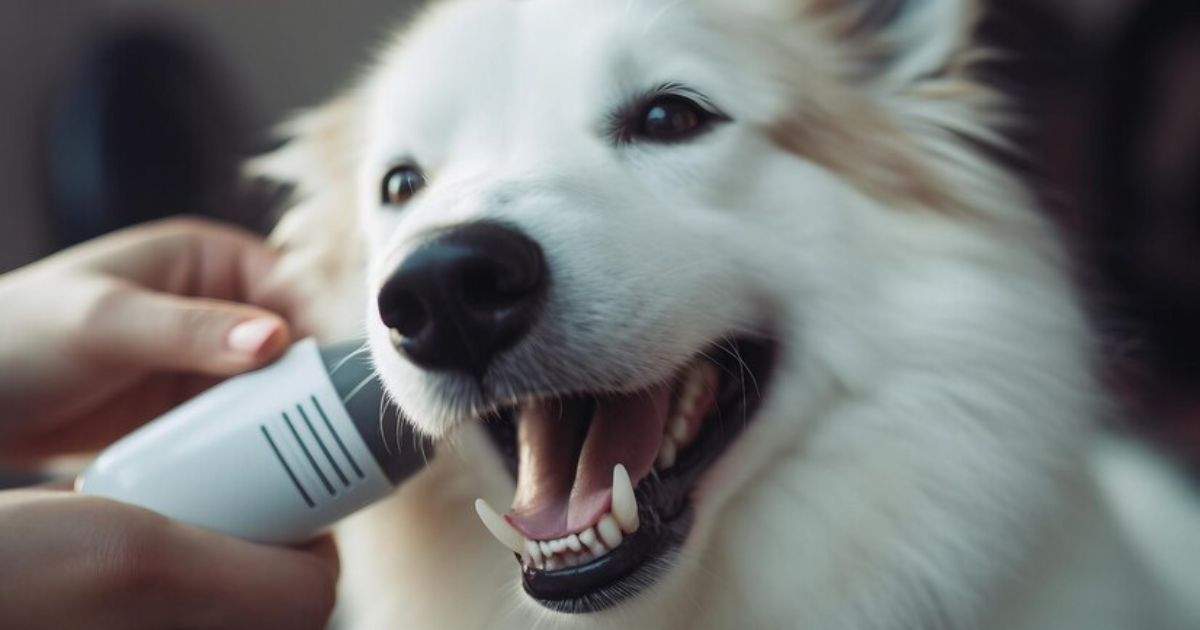In the realm of oral hygiene, a debate ensues: is a dog’s mouth is cleaner than a human’s? This question, akin to the age-old allegory of two paths diverging in a forest, sparks curiosity and raises intriguing considerations. Through a scientific lens, this article delves into the bacterial disparities between humans and canines, examines oral hygiene habits, and sheds light on the impact of diet on oral health. By dispelling common misconceptions, we aim to provide a sense of belonging and understanding to our audience seeking factual insights.
Key Takeaways
- Dogs’ mouths contain a different set of bacteria compared to humans.
- Both humans and dogs have a natural oral microbiome.
- Certain bacteria in dog mouths can contribute to periodontal disease.
- Diet plays a crucial role in maintaining optimal oral health for both humans and dogs.
The Myth of the Dirty Dog Mouth
Contrary to popular belief, the notion of a dirty dog mouth is a persistent myth that has been debunked by scientific research. Many people believe that dogs’ mouths are teeming with harmful bacteria, making their kisses and licks unhygienic. However, studies have shown that this is not the case. In fact, a dog’s mouth contains a different set of bacteria compared to a human mouth, but not necessarily more or dirtier bacteria.
Both humans and dogs have a natural oral microbiome, which is a community of microorganisms that coexist with their host. These microorganisms play a vital role in maintaining oral health. While it is important to practice good hygiene and avoid certain behaviors, such as letting dogs lick open wounds, the idea of a dirty dog mouth is unfounded.
Understanding Bacterial Differences
The bacterial differences between human and dog mouths can be better understood by examining their respective oral microbiomes. The oral microbiome refers to the community of microorganisms that reside in the mouth. Here are three key points to consider:
- Species Composition: The oral microbiome of humans and dogs differ in terms of the types of bacteria present. While both contain a wide variety of bacteria, the specific species composition can vary significantly between the two.
- Functional Differences: The oral microbiome of dogs is adapted to their diet, which often includes raw meat. This can result in a higher prevalence of certain bacteria that are associated with digestion and handling raw food. Human oral microbiomes, on the other hand, have evolved to support a more diverse diet.
- Health Implications: The differences in bacterial composition and function can have implications for oral health. Certain bacteria in the dog mouth, for example, can contribute to periodontal disease. Human mouths, on the other hand, may be more susceptible to dental caries due to the presence of acid-producing bacteria.
Understanding these bacterial differences is crucial in evaluating thecleanliness and health of human and dog mouths. In the next section, we will delve into examining the oral hygiene habits of both species.
Examining Oral Hygiene Habits
To further explore the topic of oral hygiene habits, it is essential to analyze the practices followed by both humans and dogs. Humans have established oral hygiene routines that typically include brushing their teeth twice a day, flossing, and using mouthwash. They also visit dentists regularly for professional cleanings. On the other hand, dogs rely on their owners to maintain their oral health.
This involves regularly brushing their teeth, providing dental chews or treats, and scheduling professional dental cleanings. It is important to note that while humans have a greater understanding of oral hygiene and access to specialized products, dogs can still maintain good oral health with proper care. Now, let’s delve into comparing the bacterial load in human and dog saliva to gain further insights into the cleanliness of their mouths.
Comparing Bacterial Load in Human and Dog Saliva
When comparing the bacterial load in human and dog saliva, it is evident that there are notable differences in microbial composition. The following are three important factors to consider:
- Diversity: Human saliva contains a wide range of bacterial species, including Streptococcus, Neisseria, and Haemophilus, which are part of the normal oral flora. In contrast, dog saliva has a higher diversity of bacteria, including species like Porphyromonas, Prevotella, and Fusobacterium.
- Pathogenic potential: While both human and dog saliva can contain potentially harmful bacteria, dog saliva has been found to harbor a higher number of pathogenic species, such as Capnocytophaga canimorsus, which can cause severe infections in humans.
- Oral health implications: The differences in microbial composition between human and dog saliva can have implications for oral health. For example, certain bacteria found in dog saliva have been associated with periodontal disease in humans, highlighting the importance of oral hygiene practices for both humans and their pets.
Understanding the differences in bacterial load and composition between human and dog saliva can provide valuable insights into oral health and help guide appropriate preventive measures.
Dental Health: Human Vs. Canine
In comparing dental health between humans and canines, it is important to consider the differences in oral hygiene practices and the potential impact on overall oral well-being. Humans typically brush their teeth at least twice a day, floss regularly, and visit the dentist for check-ups. On the other hand, dogs rely on their owners for oral care, which often includes regular teeth brushing and professional cleanings.
A key difference is that dogs do not use toothpaste; instead, specialized dog toothpaste or water additives are used. Additionally, humans have a more diverse diet, including a variety of fruits and vegetables, which can help promote dental health. To compare dental health in humans and canines, the following table provides a summary of key differences:
| Humans | Canines | |
|---|---|---|
| Oral Hygiene | Regular brushing, floss | Reliance on owners |
| Diet | Diverse | Limited |
| Toothpaste | Yes | No (specialized paste) |
| Professional | Regular check-ups | Periodic cleanings |
| cleanings |
The Role of Diet in Oral Health
A well-balanced diet plays a crucial role in maintaining optimal oral health for both humans and dogs. Here are three key ways in which diet impacts oral health:
- Nutrient intake: Consuming a diet rich in essential nutrients such as vitamins A, C, and D, as well as calcium and phosphorus, helps promote healthy teeth and gums. These nutrients support the growth and maintenance of strong teeth and bones, while also aiding in the production of saliva which helps to wash away food particles and neutralize acids in the mouth.
- Sugar consumption: Diets high in sugar can increase the risk of tooth decay in both humans and dogs. Sugar provides fuel for harmful bacteria in the mouth, leading to the production of acids that attack tooth enamel. Limiting the intake of sugary foods and beverages can help prevent cavities and maintain oral health.
- Chewing behavior: For dogs, chewing on appropriate toys and treats can help remove plaque and tartar buildup, reducing the risk of gum disease and tooth loss. Similarly, humans can benefit from chewing sugar-free gum, which stimulates saliva production and helps cleanse the mouth.
Dispelling Common Misconceptions
One common misconception that needs to be dispelled is the belief that a human mouth is inherently cleaner than a dog’s. While it is true that humans generally have better oral hygiene practices, it does not mean that their mouths are cleaner than dogs’. The oral environment of both humans and dogs contains millions of bacteria, some of which are beneficial and necessary for oral health.
However, dogs have a different oral microbiome than humans, which means that their mouths may contain different types and amounts of bacteria. It is important to note that the cleanliness of a mouth depends on various factors such as oral hygiene practices, diet, and individual health. Therefore, it is incorrect to assume that a human mouth is always cleaner than a dog’s.
FAQ,s
How Does the Myth of the Dirty Dog Mouth Affect People’s Perception of Dogs’ Oral Hygiene?
The myth of the dirty dog mouth can impact people’s perception of dogs’ oral hygiene. This misconception may lead individuals to believe that dogs have overall poor oral health, potentially affecting their willingness to provide proper dental care for their pets.
What Are the Main Bacterial Differences Between Human and Dog Saliva?
The main bacterial differences between human and dog saliva lie in the specific types and quantities of bacteria present. Understanding these differences is crucial for maintaining oral hygiene and preventing potential health issues in both humans and dogs.
Are There Significant Variations in Oral Hygiene Habits Between Humans and Dogs?
Significant variations in oral hygiene habits exist between humans and dogs. While humans have developed sophisticated dental care practices, dogs rely on natural mechanisms like chewing and saliva to maintain oral health.
How Does the Bacterial Load in Human Saliva Compare to That in Dog Saliva?
The bacterial load in human saliva differs from that in dog saliva due to variations in oral microbiota. Factors such as diet, oral hygiene practices, and immune system play a role in determining the composition and quantity of bacteria in each species’ saliva.
What Are the Differences in Dental Health Between Humans and Dogs?
Dental health differs between humans and dogs due to the anatomical and physiological variations in their oral cavities. Humans have a higher risk of dental caries and periodontal disease, while dogs are more prone to dental tartar and gum infections.
Conclusion
In conclusion, the belief that a human mouth is cleaner than a dog’s mouth is a myth. While there are differences in the types of bacteria found in human and dog saliva, both can harbor harmful bacteria. Maintaining good oral hygiene habits and a balanced diet are essential for both humans and dogs to promote oral health. It is important to dispel misconceptions and prioritize oral care for both humans and canines.










